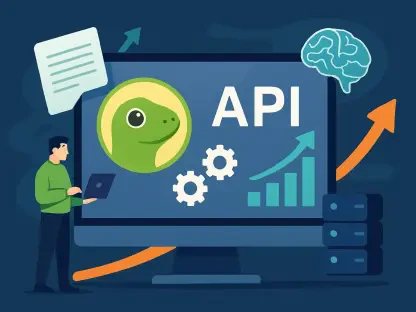As banks and financial institutions increasingly adopt AI solutions, the need for trust and compliance in these models has never been greater. ##O.ai has introduced the first comprehensive Model Risk Management (MRM) framework designed specifically for Generative AI, addressing key concerns in the industry.
Ensuring Trust and Compliance
Addressing Regulatory Needs
The financial sector is highly regulated, requiring stringent compliance measures. ##O.ai’s MRM framework provides a structured evaluation system that meets these regulatory standards, ensuring models are fair, reliable, and trustworthy. This is critical in an industry where even slight deviations from compliance can lead to significant legal and financial repercussions. The framework’s design considers the heavy oversight and detailed documentation that regulators expect from financial entities, making it a robust tool for ensuring model integrity.
The structured evaluation system also incorporates real-time monitoring and periodic assessments, which help in maintaining continuous compliance with evolving regulations. This adaptive approach is crucial for banks, which often face shifting regulatory landscapes. The framework’s ability to detect and address model biases, inaccuracies, and potential risks before they become issues is particularly beneficial for maintaining trust and ensuring long-term compliance.
Transparency and Fairness
One of the main challenges with AI in banking is achieving transparency. The framework offers tools for automated and human-calibrated evaluations, bias detection, and explainability, which are crucial for maintaining trust. Transparency in model decision-making processes allows stakeholders to understand how and why decisions are made, thereby reducing the risk of biases and ensuring fairness. The ability to provide clear explanations about model outputs enables both internal teams and external regulators to scrutinize and validate model decisions more effectively.
The framework’s built-in tools for bias detection are geared towards identifying and mitigating biases that could lead to unfair decisions. This includes a range of statistical and algorithmic methods designed to reveal hidden biases that may not be immediately apparent. By employing these tools, financial institutions can ensure their AI models do not inadvertently perpetuate existing inequalities or introduce new ones, thus reinforcing trust and fairness in their operations.
Robust and Transparent Evaluations
Automated Testing Techniques
The MRM framework uses advanced techniques like topic modeling, stratified sampling, and LLM-based test generation. These automated tests are essential for assessing the models’ performance and identifying potential weaknesses. Topic modeling helps in understanding the thematic structures within the data, while stratified sampling ensures that all relevant data segments are adequately represented during testing. This multifaceted approach enables a thorough and nuanced evaluation of model capabilities.
By incorporating techniques such as LLM-based test generation, the framework can simulate a wide variety of scenarios and use cases, which helps in identifying edge cases and performance limitations. The automated nature of these tests allows for extensive testing coverage without the need for constant human oversight, making the evaluation process both efficient and exhaustive. This ensures that potential weaknesses are identified early, allowing for timely improvements and adaptations.
Human-Calibrated Evaluations
Supplementing automated methods with human-calibrated evaluations ensures that the machine’s assessments align with human judgment. This dual approach enhances the reliability of the evaluations. Human evaluators provide context and insights that automated systems might miss, bridging the gap between machine efficiency and human intuition. This balanced interplay between automated and human assessments results in a more robust and dependable evaluation process.
Human-calibrated evaluations also ensure that ethical considerations and practical implications are factored into the validation process. Human reviewers can assess the broader impact of model decisions on stakeholders, taking into account societal norms and values. This holistic approach to evaluation is vital in sectors like banking, where decisions can have far-reaching consequences. By involving human judgment, the evaluation process gains additional layers of depth and reliability.
Identifying and Mitigating Risks
Weakness Detection
The framework identifies low-performance areas through bivariate analysis and failure clustering. This allows banks to focus on targeted improvements, ensuring robust and reliable models. Bivariate analysis helps in understanding the relationship between different model variables and identifying areas where the model might not perform optimally. Failure clustering groups similar failure patterns together, enabling a detailed examination of recurring issues and fostering more effective problem-solving strategies.
These techniques not only pinpoint weaknesses but also guide the development of corrective measures. By understanding the specific circumstances under which models underperform, banks can implement targeted enhancements that address these vulnerabilities. This proactive approach to risk mitigation ensures that models remain robust and trustworthy, even as they evolve and are applied to new data sets and scenarios.
Adversarial Robustness
Testing the models with adversarial inputs and out-of-distribution queries helps in assessing the robustness of the AI systems. This is crucial for maintaining security and preventing vulnerabilities. Adversarial testing simulates scenarios where the model might be deliberately challenged by malicious inputs, ensuring that it can withstand such threats and continue to perform reliably. Out-of-distribution queries assess the model’s ability to generalize and handle data that falls outside its normal training scope.
Both types of testing contribute to a comprehensive understanding of model robustness. By ensuring that models can handle unexpected or intentionally disruptive inputs, banks can safeguard against potential security breaches and ensure the continuity of reliable service. This aspect of the MRM framework is particularly important in the financial sector, where the stakes for security and reliability are exceptionally high.
Deployment and Security
On-Premise Solutions
To comply with data sovereignty and privacy regulations, ##O.ai’s MRM capabilities offer air-gapped and on-premise deployment options. This ensures data remains secure and within the institution’s control. On-premise solutions eliminate the risks associated with data transfer and third-party handling, providing an added layer of security and compliance. By keeping sensitive data within the confines of the institution, banks can meet stringent privacy mandates and reduce exposure to data breaches and leaks.
Air-gapped deployments further enhance security by physically isolating the system from unsecured networks, ensuring that sensitive information cannot be accessed remotely. This robust security setup is particularly beneficial for financial institutions, which handle vast amounts of personally identifiable information and financial data. By offering these secure deployment options, the MRM framework helps banks maintain the highest levels of data integrity and confidentiality.
Reducing Third-Party Risks
By enabling on-premise validation and monitoring, the framework reduces the risks associated with third-party handling of sensitive data, providing banks with greater peace of mind. Third-party data handling often introduces vulnerabilities, as it can be challenging to ensure consistent data protection standards across different entities. On-premise solutions mitigate this risk by keeping all data processing within the control of the bank.
This approach also allows for more rigorous monitoring and validation processes, as internal teams have direct access to and oversight of the data. It enables quicker detection and response to potential issues, fostering a more secure and reliable environment for AI model deployment. The ability to internally manage data not only enhances security but also strengthens the bank’s accountability and control over its AI systems.
Scaling AI Expertise in Banking
Training Initiatives
##O.ai has been proactive in training AI practitioners and risk teams within financial institutions. This allows banks to build internal expertise, reducing reliance on external validation, and speeding up AI deployment. By investing in comprehensive training programs, ##O.ai empowers financial institutions to develop a deep understanding of AI technologies and best practices. This internal capacity building is crucial for ensuring that banks can effectively manage and leverage AI solutions independently.
The training initiatives cover various aspects of AI, from model development and validation to risk management and compliance. This holistic approach ensures that teams are well-equipped to handle the complexities of AI deployment in the financial sector. As a result, banks can achieve greater operational efficiency, reduce costs associated with external consultants, and foster a culture of continuous learning and innovation.
Industry Partnerships
The company’s robust collaboration with major corporations like Dell, Deloitte, and NVIDIA highlights its industry leadership and commitment to advancing AI capabilities in financial services. These partnerships bring together diverse expertise and resources, driving innovation and enabling the development of cutting-edge AI solutions. By working with industry leaders, ##O.ai ensures that its products and services are at the forefront of technological advancements.
These collaborations also facilitate the exchange of knowledge and best practices, fostering a collaborative ecosystem that benefits the entire financial sector. By partnering with leading corporations, ##O.ai can leverage their combined strengths to address complex challenges and create more robust and scalable AI solutions. This synergy enhances the overall value proposition of the MRM framework, making it a powerful tool for banks looking to harness the full potential of AI.
##O.ai’s Role in the AI Community
Global Impact
Founded in 2012, ##O.ai has transformed over 20,000 organizations worldwide, including more than half of the Fortune 500. Its extensive reach underscores its pivotal role in the AI industry. The company’s open-source tools and enterprise solutions have democratized AI, making advanced technologies accessible to a wide range of organizations. This inclusivity has accelerated AI adoption across various sectors, driving innovation and improving operational efficiencies.
##O.ai’s impact extends beyond mere numbers; its contributions have fundamentally changed how industries approach AI. By providing scalable and adaptable solutions, the company has enabled businesses to integrate AI into their core operations seamlessly. This transformative power has positioned ##O.ai as a leader in the AI community, influencing the direction of AI development and application on a global scale.
AI for Good
As banks and financial institutions increasingly turn to AI solutions, the need for trust and regulatory compliance in these models has become more critical than ever. Proper oversight ensures that AI systems operate as intended, without posing risks to the financial sector or its customers. In response to this growing need, ##O.ai has introduced an industry-first comprehensive Model Risk Management (MRM) framework specifically designed for Generative AI. This framework is tailored to address the unique challenges and key concerns faced by the financial industry when implementing AI-driven models. By providing a structured approach to managing risks, ##O.ai’s MRM framework aims to ensure that generative AI models are both reliable and compliant with regulatory standards. This innovation allows banks and financial institutions to confidently deploy and benefit from AI technologies while mitigating potential risks. Through this proactive approach, ##O.ai supports a safer and more resilient financial landscape, meeting the evolving demands for trust and compliance in AI advancements.









